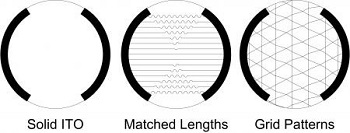Reynard Corporation, a leading global supplier of optical components and thin film coatings, has now made available custom optical heated windows that utilize conductive materials. Heated windows are the most cost effective way to keep imaging planes or optical instrumentation windows free of moisture or fog.

Reynard's optical heated window patterns can be customized in design to achieve high transmission with matched impedance to meet the exacting requirements of almost any system. The substrate size, shape, and type can also be customized to meet the specific requirements.
Bus bars added to the edge of the optics provide solder points for electrical leads. Adding an anti-reflection coating to one or two sides of the optic provides enhanced transmission while providing an extra layer of protection to the conductive surface.
Several types of heated window are available.
Solid ITO provides a highly transparent and conductive film over the surface of the optic for visible and NIR wavelengths. The controlled thickness of the applied ITO controls the impedance.
Another type uses bus bar to bus bar lines. These are typically required to be matched in length for controlled impedance. They can be applied from either ITO or highly conductive metals, such as gold.
A third type uses grid patterns to provide a balance between impedance control, high transmission, and robustness. Grid patterns are typically used when the optic is in environments where the gird surface may be scratched, yet impedance control needs to be maintained. Patterns can be applied from either ITO or highly conductive metals.
Key features include customized or standard patterns down to 5um line widths, use of highly conductive materials such as ITO or gold, and high transmission in the desired wavelength spectrum from visible to far IR. Application can be made to most substrates including thick optics, plastics, and flexible membranes.
"Without a heated window, condensation buildup in the viewing window of an imaging system could deem the entire system ineffective," said Randy Reynard, President of Reynard Corporation.
"Systems that quickly traverse from cold to warm environmental conditions see condensation buildup due to slow thermal mass changes in the system compared to the external environment. Heating the imaging window so that it thermally matches external environmental conditions eliminates condensation buildup."